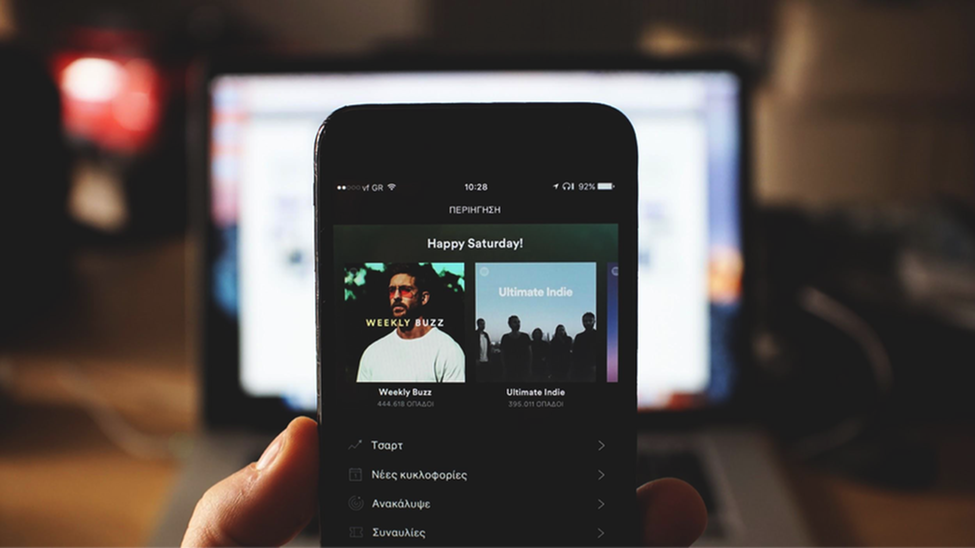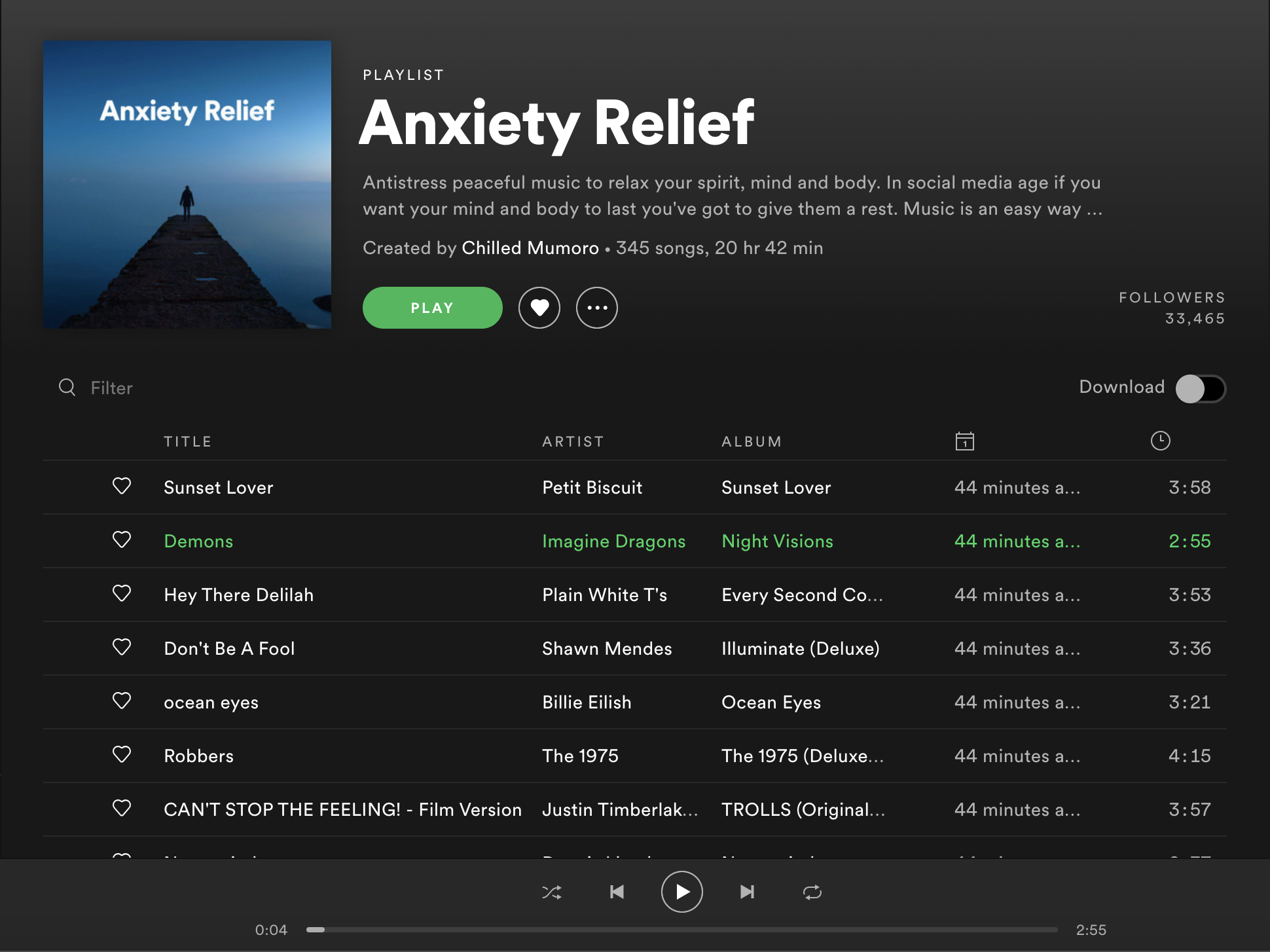13 Spotify Playlists for Chronic Anxiety
Sound has proven time and again to help with a whole range of emotions. In fact, just saying calming words out loud to yourself can help some people get rid of a severe anxiety attack. If you need help right now due to an oncoming panic attack, try repeating these words out loud:
“Abnormal feelings in abnormal circumstances are perfectly normal.”
Bookmark, screenshot, take a pic, and/or take note of the above saying so that you can use it whenever you feel an anxiety attack coming on or when you’re smack bang in the midst of one. The reason that anxiety exists is to signal your fight or flight reaction due to impending danger. But that was when we had lions to get away from and now it presents itself due to modern stresses. So, it’s an emotion just like any other and needs to be acknowledged rather than suppressed. Aside from being super catchy, this affirmation tells your brain that everything is ok and that your reaction to odd circumstances is perfectly ok too. Naming your emotions is another great trick to get outside of your head and back safely to the present moment.

Music can act as outside help to a battle going on inside a person. Some people are non-verbal and can’t say affirmations out loud, and some don’t always want the presence of another person. So, music can be absolutely key. This is an inclusive post focusing on 13 Spotify playlists for reducing anxiety for adults with ADD, ADHD, autism, and other people who deal with chronic anxiety on a regular basis. So, without further ado, here are 13 Spotify playlists for reducing chronic anxiety.
Anxiety Disorder Relief Playlist
Do you have a lover of water sounds in the house? This is the most extensive collection of calming water sounds we’ve ever heard! It has your general rain/jungle rain/lapping beach waves assortment along with some binaural-style songs (although they don’t actually specify that they are binaural tunes).
Style: Zen nature sounds
Lyrics? No
Anxiety Relief Playlist
The aptly named Anxiety Relief soundtrack is a peaceful yet upbeat modern pop song collection including tunes from Imagine Dragons, Billie Ellish, and even Justin Timberlake. With an overall chill and happy vibe, this soundtrack could easily relieve anxiety for those who don’t mind having lyrics.
Style: Indie pop
Lyrics? Yes
Relaxing White, Pink & Brown Noise
White noise? Got that and two others but what’s the difference? “Individuals with autism have an increased auditory perceptual capacity. What will each of these types of sound do for an individual with autism? To answer the latter of the two questions, you have to take it on an individual basis–what works nicely for one person may not for the next. To answer the former question and give more insight for the latter, we’ll need to look into some the different types of noise:
White Noise
Perhaps the most well-known of all of the noises, white noise lends a constant noise across all frequencies. By this, we mean that it includes all the sounds from the audible spectrum and no hidden sounds that are usually outside of the audible spectrum for humans.
White noise is particularly good for masking sounds in a loud environment. A car alarm beeping, for instance, can be pretty unbearable for some people. At the right volume/through headphones, white noise can mask the sound of a car beeping because it surrounds it with other sounds on the human audible spectrum. White noise has an unwavering humming sound. In everyday life, white sounds can be found in radio or television static, whirring fans, or a humming air conditioner.
Pink Noise
Whereas white noise lends a consistent sound across all frequencies, pink noise is a mix of high and low frequencies. It is thought (but not entirely proven) that pink noise is easier to listen to and more calming than white noise. However, some people prefer the consistency of white noise to the variables of pink noise.
Pink noise can also be identified by a bass-rumble kind of tone that makes it deeper than white noise. Pink noise represents itself in nature through sounds like rustling leaves, steady rain, wind, heartbeats. Pink noise is also especially good for sleep (or getting babies to sleep!) because its rhythmic tone is similar to the heartbeat heard and felt in the womb.
Pink noise is slowly showing up as the subject of scientific studies. One notable study, in the Journal of Theoretical Biology, found that pink noise reduces brain waves, which promotes consistent sleep. In the same way, pink noise acts as a calming tool.
Black Noise
Black noise is a little like a black hole in that it describes a lack of noise. Black noise is either complete silence or mostly silence with short pieces of randomized noise. Some people prefer complete silence when sleeping or in general.
Brown Noise
Brown noise is also referred to as red noise and it has higher energy at lower frequencies. Adversely, this makes it deeper than pink and white noise. According to limited research, brown noise has shown promise in promoting deep relaxation and sleep for those who prefer bass sounds.
To the human ear, brown noise can often sound like white noise. Examples of brown noise include thunder, low roaring, and strong waterfalls.
Some people enjoy white/pink/brown noises, whereas others prefer to pop on soundproof headphones. Studies surrounding these noises and people with autism have generally focused on white noise because it has the power to mask other loud, overstimulating, or otherwise frightening sounds. Again, it really is up to the individual.
Calming Piano Music
This playlist has soft piano with twinkling sounds. It sits somewhere between an upbeat, “what a beautiful day and my life has just changed for the better” style that you’ll find in some movie soundtracks and about a 5th of the way through the Casper the Friendly Ghost theme tune (which is just truly lovely).
Style: Soft, twinkling piano
Lyrics: No
Anti-Anxiety Playlist
The Anti-Anxiety playlist on Spotify is a curated mixture of pure bliss. It includes all of the favorites such as piano, choir, strings, pan pipes, heartbeats, and nature sounds. Someone went to a great deal of detail in creating this playlist.
Style: Calming mix
Lyrics: Only choir sounds
Baby Lullaby Piano Rain Sounds
This playlist is an intersection of slow, soft rain, and piano tunes. Very almost fell asleep while writing this piece and listening to this soundtrack. The piano is bright and cerebral and the rain gentle; not too loud or fast. Think Frédéric Chopin playing in slow motion next to a babbling brook.
Style: Soft piano and rain
Lyrics? No
Frédéric Chopin
Frédéric Chopin was a Polish-French composer and piano teacher during the Romantic Era. As a baby, Chopin was always moved by the piano playing of his mother and sister. By age six he was already trying to reproduce what he heard. Chopin published his own first composition at age 7 and began performing one year later.
Style: His style of playing is light and very delicate.
Lyrics? No
Binaural Beats
A binaural tune must be under 1000Hz to count. The reason is that it is actually two tones and not one. In order to work, the two tones cannot be more than 30Hz in difference. But, why? As your brain hears these sounds, it makes a third beat at the difference of the frequencies producing what some call a “digital illusion.”
While the studies a still few and far between, it is thought that alpha and theta binaural beats reduce anxiety and delta binaural sounds promote deep sleep. Delta brainwaves are naturally elevated at night. In neurotypical people, the delta brainwaves see a reduction during daylight, but for many people with autism, delta waves remain over-active during the daytime. This causes many of the symptoms and distractions typically associated with people on the spectrum as they struggle to cut through their mental noise. So, although delta can be calming for some, it can lead to overstimulation and distractions for others. For that reason, we will only concentrate on alpha and theta binaural beats for this post.
Beta and gamma sound waves are thought to arouse the senses and help with concentration. Gamma may be a little too stimulating for some and have an adverse effect. Beta is used by people with ADD and ADHD to help with focus without overstimulation. The next playlists have been handpicked to help with reducing anxiety:
Binaural Beats: Alpha Brainwaves
Style: Wobbly sound waves (like something out of a 1950s sci-fi film)
Lyrics? No
Theta Binaural Beats
Style: Softer sound waves
Lyrics? No
Binaural Beats for Sleep
Style: Medium sound waves with nature, sound effect, and gentle musical instrument overlays
Lyrics? No
To sum up, there have been countless studies that prove that music has a real effect on the brain. From people in comas being able to hear and appreciate music to the “Mozart Effect,” sound has been a key part of who we are for a very long time. With this, it’s extremely possible that music has the power to reduce chronic anxiety.



